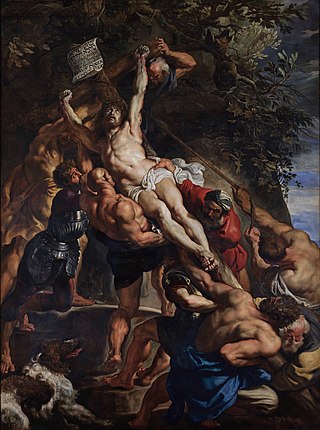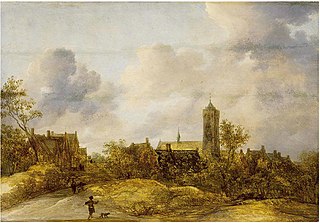
Jan Brueghelthe Elder was a Flemish painter and draughtsman. He was the son of the eminent Flemish Renaissance painter Pieter Bruegel the Elder. A close friend and frequent collaborator with Peter Paul Rubens, the two artists were the leading Flemish painters in the first three decades of the 17th century.

Louis de Caullery, Caulery or Coulery (ca.1580–1621) was a Flemish painter who is known for his architectural scenes, city views, genre scenes, allegorical compositions and history paintings. He was one of the pioneers of the art genre of courtly gatherings and the garden parties in Flemish painting.

Joos de Momper the Younger or Joost de Momper the Younger was a Flemish landscape painter active in Antwerp between the late 16th century and the early 17th century. Brueghel's influence is clearly evident in many of de Momper's paintings. His work is situated at the transition from late 16th-century Mannerism to the greater realism in landscape painting that developed in the early 17th century. He achieved considerable success during his lifetime.

Pieter van Bloemen, also known as Standaart, first name also spelled Peter or Peeter, was a Flemish painter, draughtsman and printmaker. He was a gifted landscape and animal artist and was very successful with his compositions depicting Italian landscapes with figures, equestrian battles, animals and genre and market scenes.

Peter Snayers or Pieter Snayers (1592–1667) was a Flemish painter known for his panoramic battle scenes, depictions of cavalry skirmishes, attacks on villages, coaches and convoys and hunting scenes. He established his reputation mainly through his topographic battle scenes providing a bird's eye view over the battlefield. He further painted large landscapes and portraits of the aristocracy. He was a regular collaborator of local landscape painters and also Rubens.

Marten Ryckaert or Maerten Ryckaert, was a Flemish landscape painter. He was known for his small, usually imaginary landscapes in an Italianate style.

Flemish Baroque painting was a style of painting in the Southern Netherlands during Spanish control in the 16th and 17th centuries. The period roughly begins when the Dutch Republic was split from the Habsburg Spain regions to the south with the Spanish recapturing of Antwerp in 1585 and goes until about 1700, when Spanish Habsburg authority ended with the death of King Charles II. Antwerp, home to the prominent artists Peter Paul Rubens, Anthony van Dyck, and Jacob Jordaens, was the artistic nexus, while other notable cities include Brussels and Ghent.

Abraham Govaerts was a Flemish painter who specialized in small cabinet-sized forest landscapes in the manner of Jan Brueghel the Elder and Gillis van Coninxloo. He was a regular collaborator with other artists who were specialists in specific genres. Govaerts would paint the landscape while these specialists painted the figures, animals or still life elements.

David de Coninck or David de Koninck, also known as Rammelaer was a Flemish painter who specialised in still lifes and landscapes with animals and hunting scenes. Recognised as a leading animal painter, de Coninck was able to develop an international career which caused him to work for extended periods in Paris, Rome and Vienna.

Jacques Fouquier, Jacques Fouquières or Jacob Focquier was a Flemish landscape painter. After training in Antwerp he worked in various places where he often obtained appointments as a painter to the court including that of the French kings. He earned great success and a very high reputation during his lifetime and was even referred to as the 'Flemish Titian'. Very few of his paintings have been preserved. His work was influential in his time and was widely circulated thanks to reproductions by various contemporary engravers.

Anton Goubau or Anton Goebouw was a Flemish Baroque painter. He spent time in Rome where he moved in the circle of the Bamboccianti, Dutch and Flemish genre painters who created small cabinet paintings of the everyday life of the lower classes in Rome and its countryside. He is known for his Italianate landscapes and genre paintings in the style of the Bamboccianti and his history paintings with mythological and religious themes.

Jacob Ferdinand Voet or Jakob Ferdinand Voet was a Flemish portrait painter. He had an international career that brought him to Italy and France, where he made portraits for an elite clientele. Voet is regarded as one of the best and most fashionable portrait painters of the High Baroque.

Frans de Momper was a Flemish landscape painter who, after training in Antwerp, worked for a while in the Dutch Republic. Here he was exposed to the work of Dutch landscape painters such as Jan van Goyen. His later paintings prefigure the imaginative landscapes of Hercules Segers.

Philips de Momper the Elder, Philips de Momper (I) or Philippe de Momper (I) (1598–1634) was a Flemish landscape painter and son of the prominent landscape painter Joos de Momper. His work was virtually unknown until a group of paintings, mainly depicting Treviso and Rome, which had formerly been attributed to his father were re-assigned to him. The artist is often confused with his cousin Philips de Momper the Younger (or Philips de Momper (II)) (c. 1610-1675).
Hendrik Frans van Lint was a Flemish landscape and vedute painter who was part of the group of Flemish and Dutch painters active in Rome. He was one of the leading landscape painters in Rome in the first half of the 18th century and his patrons included Rome's old aristocratic families as well as European travellers on their Grand Tour.

Jan van Essen, was a Flemish painter known for his seascapes. After training in Antwerp, he worked in Italy, particularly in Rome and Naples.

Vincent Adriaenssen (1595–1675) was a Flemish Baroque painter who spent an important part of his career in Paris and Rome where he was especially renowned for his landscapes with battles and hunting scenes.
The family de Momper was a Flemish family of painters and printmakers active in the 16th and 17th century. The family originated in Bruges but had settled in Antwerp by the 1550s. Members of the family include:

Bartholomeus de Momper (I) or Bartholomeus de Momper the Elder (Antwerp, 1535 – Antwerp, between 1595-1597) was a Flemish publisher, printer, draughtsman and art dealer. He was a member of de Momper family, a prominent family of landscape painters and printmakers, originally from Bruges, which had settled in Antwerp in the 16th century.

Grotto Landscape with a Hermitage, also called The Reading Hermit, is an oil on canvas painting by Flemish painters Jan Brueghel the Younger and Joos de Momper. It was painted around 1625, and is currently in private collection. It depicts a reading hermit in a monumental grotto, several pilgrims and various animals. It was painted in Antwerp.






















